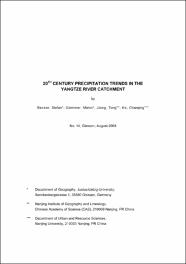| dc.contributor.author | Becker, Stefan | |
| dc.contributor.author | Gemmer, Marco | |
| dc.contributor.author | Jiang, Tong | |
| dc.contributor.author | Ke, Chanqing | |
| dc.date.accessioned | 2022-08-10T13:50:50Z | |
| dc.date.available | 2004-01-08T14:32:39Z | |
| dc.date.available | 2022-08-10T13:50:50Z | |
| dc.date.issued | 2003 | |
| dc.identifier.uri | http://nbn-resolving.de/urn:nbn:de:hebis:26-opus-13738 | |
| dc.identifier.uri | https://jlupub.ub.uni-giessen.de//handle/jlupub/6325 | |
| dc.identifier.uri | http://dx.doi.org/10.22029/jlupub-5776 | |
| dc.description.abstract | The 1990´s Precipitation at 16 stations in the Yangtze River Catchment within the context of 20th century time-series has been analysed. Linear trends, decadal fluctuations, occurrence of extreme years, and inter-annual variability of annual precipitation have been examined with special focus on 90s precipitation. Changes in monthly precipitation were analysed by decadal comparison, analyses of inner-annual variabilities and Mann-Kendall trend tests.
No general increase or trend of the annual precipitation and its variability in the Yangtze river catchment has been detected. Decadal-scale fluctuations of precipitation are apparent for the whole time series. The 1990s were no exceptionally wet decade concerning annual precipitation in the context of 20th century. Nevertheless, it becomes obvious that the 90s take on an exceptional position, as at comparatively many stations more than one wet year (precipitation above 90% quantile of station's data) occurred during this decade.
An interesting feature of this study is the observation of relatively large differences in seasonal trends. Some months became distinctively wetter at some stations in the 90s whereas others showed the opposite trend. Most stations display a slight or considerable increase of the inner-annual variability from the 80s to the 90s, however, the values in the 90s were often superseded in earlier decades. Most stations also show a decrease of the average precipitation in May in the 90s whereas an increase of the average precipitation in June and July in comparison to all or most previous decades is significant. The situation in August is diverse, but a significant increase of rainfall at many stations in months with maximum precipitation between 1950 and 1999 can be detected. It is noteworthy that the positive trends for the summer months are often preceded or followed by significant negative trends in the earlier and/or later months. This is an indication for the tendency towards a concentration of summer rainfall within a shorter period of time. The relevancy of this trend for the development of flood events is apparent and will be analysed in further studies. | en |
| dc.language.iso | en | de_DE |
| dc.relation.ispartofseries | Discussion papers / Zentrum für Internationale Entwicklungs- und Umweltforschung; 14 | |
| dc.rights | Namensnennung - Nicht-kommerziell - Keine Bearbeitung 3.0 Deutschland | * |
| dc.rights.uri | https://creativecommons.org/licenses/by-nc-nd/3.0/de/ | * |
| dc.subject | Jangtsekiang | de_DE |
| dc.subject | Stausee | de_DE |
| dc.subject.ddc | ddc:910 | de_DE |
| dc.title | 20th century precipitation trends in the Yangtze river catchment | en |
| dc.type | workingPaper | de_DE |
| local.affiliation | ZEU Zentrum für internationale Entwicklungs- und Umweltforschung | de_DE |
| local.opus.id | 1373 | |
| local.opus.institute | Zentrum für internationale Entwicklungs- und Umweltforschung | de_DE |
| local.opus.fachgebiet | Zentrum für internationale Entwicklungs- und Umweltforschung | de_DE |



